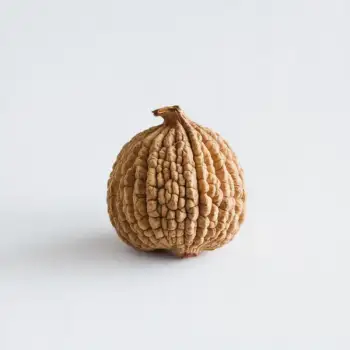Cinnamon is a sweet, warm spice from the inner bark of Cinnamomum trees, while nutmeg is a rich, nutty spice from the seed of the nutmeg tree. Both are used to enhance the flavors of sweet and savory dishes, with distinct tastes and culinary applications.

Cinnamon is a warm, sweet spice obtained from the inner bark of several tree species from the genus Cinnamomum. Used in both sweet and savory dishes, it's beloved worldwide for its distinctive flavor and aroma.

Nutmeg is a spice made from the seed of the nutmeg tree (Myristica fragrans). With its rich, nutty flavor, it's commonly used in baking, but also adds a special touch to savory dishes.
Cinnamon is known for its sweet, woody flavor, while nutmeg offers a slightly sweeter and nutty taste with a hint of clove. The texture of cinnamon is often found in stick or ground form, whereas nutmeg is typically grated fresh or bought pre-ground. Cinnamon is derived from tree bark, while nutmeg is the seed of a fruit. Their distinct flavors and uses make them stand out in different culinary preparations.

Your ultimate Recipe Box, Meal Planner, and Cooking Class all in one
Cinnamon is essential in recipes like cinnamon rolls, apple pie, and snickerdoodles. It provides a warm and comforting flavor and can be used as both a primary and complementary spice. Cinnamon sticks are often used to infuse flavor into hot drinks and poached fruits. Nutmeg shines in baked goods such as spice cakes, custards, and eggnog. It pairs well with creamy textures and is often used sparingly due to its potent flavor. A small amount of nutmeg can enhance sweetness and add depth to your baked treats.
Cinnamon is a popular addition to coffee, hot chocolate, and mulled wines, offering a spicy kick that complements the beverage's sweetness. Cinnamon sticks serve as both stirrers and flavor infusers in these drinks. Nutmeg's subtle warmth is perfect for creamy beverages like eggnog, chai lattes, and certain cocktails. Grated nutmeg on top of a drink adds a visually appealing touch as well as a burst of flavor with each sip.
Cinnamon adds a complex sweetness to Middle Eastern dishes, stews, and marinades. It's a key ingredient in spice blends like garam masala and can be used to balance out the flavors of meat and vegetable dishes. Nutmeg is commonly found in Italian cuisine, especially in béchamel sauce and spinach dishes. It can also enhance the taste of potato dishes, soups, and sausages. Its versatility in savory dishes should not be underestimated.
Both cinnamon and nutmeg are used in such small amounts that their nutritional differences are minimal in the context of an overall diet. However, they do offer various health benefits, including anti-inflammatory properties and antioxidants.
| Nutrient | Nutmeg ( per Teaspoon ) | Cinnamon ( per Teaspoon ) |
|---|---|---|
| Fat | 0.8g | 0.03g |
| Sodium | 0.6mg | 0mg |
| Calcium | 7mg | 26mg |
| Protein | 0.13g | 0.1g |
| Calories | 12 | 6 |
| Carbohydrates | 1.1g | 2g |
Cinnamon can sometimes be used as a substitute for nutmeg, especially in sweet dishes, but the resulting flavor will be different. It is not a direct substitute due to the variance in their flavor profiles.
Nutmeg is generally considered to be stronger in flavor than cinnamon and is typically used in smaller quantities.
While both spices are commonly used in pumpkin pie, they are not entirely interchangeable. Each contributes a different flavor, and most recipes call for a blend of both spices.
Ground spices are more convenient and provide immediate flavor, while whole spices, like cinnamon sticks and whole nutmeg, offer a fresher taste and can be grated as needed. The choice depends on personal preference and the recipe's requirements.
Absolutely! Cinnamon and nutmeg often complement each other in recipes, particularly in baked goods and autumnal dishes, enhancing the overall flavor complexity.